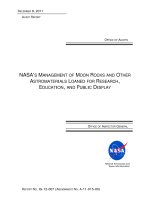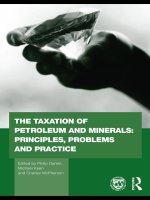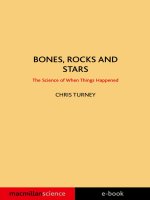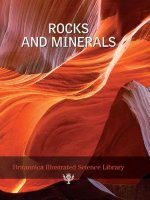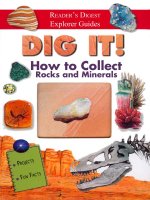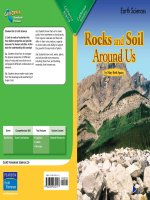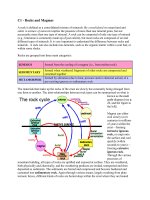Rocks and minerals
Bạn đang xem bản rút gọn của tài liệu. Xem và tải ngay bản đầy đủ của tài liệu tại đây (1.36 MB, 52 trang )
• Rocks and Minerals
• No other planet in the solar system has the unique
combination of fluids of Earth. Earth has a surface
that is mostly covered with liquid water, water vapor
in the atmosphere, and both frozen and liquid water
on the land.
• Solid Earth Materials
• Earth’s Molten Stage
– During the early formation of the Earth it was molten
– During this stage the heavier elements such as iron and
nickel, sank to the deeper interior of the Earth.
– This left a thin layer of lighter materials on the surface
that is mow called the crust.
– The majority of the Earth’s mass lies below the crust
• Chemical Analysis
– 8 elements make up 98.6% of the crust
– These 8 elements make up the solid materials of the
Earth’s crust and are known as rocks and minerals.
– A mineral is solid inorganic material of the Earth that
has both a known chemical composition and a crystalline
structure that is unique to that mineral
– A rock is a solid aggregate of one or more minerals that
have been cohesively brought together by a rock-forming
process.
• (A)The percentage by
weight of the elements
that make up Earth's
crust. (B) The
percentage by weight
of the elements that
make up the whole
Earth.
• Minerals
• Introduction
– Minerals
• A mineral is solid inorganic material of the Earth that has both
a known chemical composition and a crystalline structure that
is unique to that mineral
– Rocks
• A rock is a solid aggregate of one or more minerals that have
been cohesively brought together by a rock-forming process.
• Crystal Structures
– Can be made up of atoms of one or more kinds of
elements.
– Crystals are classified according to six major groups,
with subdivisions of each.
• A crystal is composed of a structural unit that is repeated in
three dimensions. This is the basic structural unit of a
crystal of sodium chloride, the mineral halite.
• The structural unit for a crystal of table salt, sodium
chloride, is cubic, as you can see in the individual grains.
• These quartz crystals are hexagonal prisms.
• Crystalline substances are
classified into six major systems:
isometric, hexagonal, tetragonal,
orthorhombic, monoclinic, and
triclinic. The six systems are
based on the arrangement of
crystal axes, which reflect how
the atoms or molecules are
arranged inside. For example,
crystals in the orthorhombic
system have three axes of
different lengths intersecting at
90O angles while crystals in the
hexagonal system have three
horizontal axes intersecting at 60O
and one vertical axis. Some
common examples in each system
• (A)The geometric shape
of a tetrahedron with
four equal sides. (B) A
silicon and four oxygen
atoms are arranged in the
shape of a tetrahedron
with the silicon in the
center. This is the basic
building block of all
silicate minerals.
• (A)Isolated silicon-oxygen tetrahedra do not share oxygens.
This structure occurs in the mineral olivine. (B) Single
chains of tetrahedra are formed by each silicon ion having
two oxygens all to itself and sharing two with other silicons
at the same time. This structure occurs in augite. (C) Double
chains of tetrahedra are formed by silicon ions sharing
either two or three oxygens. This structure occurs in
hornblende. (D) The sheet structure in which each silicon
shares three oxygens occurs in the micas, resulting in layers
that pull off easily because of cleavage between the sheets.
• Silicates and Nonsilicates
– Silicates – made of silicon and oxygen and make up 92 % of
Earth’s crust.
• Ferromagnesian Silicates
– made of iron, magnesium, and silicates
– Form a basic tetrahederal structure.
– Higher density and darker color than other silicates due to
the presence of iron and magnesium
• Nonferromagnesiam Silicates
– silicates that do not contain either iron or magnesium.
– Lower density and lighter color than the ferromagnesian
silicates.
• Compare the dark colors of the ferromagnesian silicates
augite (right), hornblende (left), and biotite to the lightcolored nonferromagnesian silicates.
• Compare the light colors of the nonferromagnesian silicates
mica (front center), white and pink orthoclase (top and
center), and quartz, to the dark-colored ferromagnesian
silicates.
– Structure of silicates
• Isolated tetrahedrons
• Chain silicates
• Sheet silicates
• Framework silicates
– Nonsilicates – make up 8% of Earth’s crust
• Carbonates
• Sulfates
• Oxides
• Sulfides
• Halides
• Phosphates
• Hydroxides
• Native elements
• Physical Properties of Minerals
– Color
• A visual measure.
• Not very useful for identification as color of minerals varies
considerably.
– Streak
• This is the color of the mineral when it is finely powdered.
• Rubbed across a piece of tile, leaving a fine powder of the
mineral on the tile.
– Hardness
• Resistance of the material to being scratched.
• Measured using the Mohs hardness scale, which compares the
hardness of the mineral to 10 reference minerals.
• (A)Gypsum, with a hardness of 2, is easily scratched
by a fingernail. (B) Quartz, with a hardness of 7, is
so hard that even a metal file will not scratch it.
– Crystal form
• Related to the internal geometric arrangement of the atoms that
make up the crystal structure.
– Cleavage
• the tendency of mineral to break along smooth planes.
• Depends upon zones of weakness in the crystal structure.
– Fracture
• The broken surface is irregular and not in a flat plane.
– Luster
• Surface sheen
• Metallic – like metal
• Pearly – like pearl
• Vitreous – like glass
• Earthy
– Density – ratio of the mass of a mineral to its volume.
• Specific gravity – ratio of mineral density to the
density of water
• Depends on:
– Kind of atoms which make up the mineral
– How the atoms are arranged in the crystal lattice.
• Mineral-forming Processes
